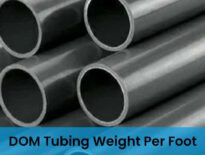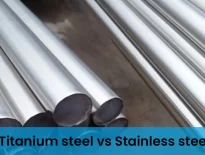DOM tubing isn’t just a type of tube; it refers to the process used to create it. The Drawn Over Mandrel method begins with an electrically welded tube (ERW), which is then cold drawn through a die and over a mandrel. The size and angle of the die determine the Outside Diameter (OD), while the mandrel defines the Inside Diameter (ID). After this initial shaping, the tubing undergoes multiple passes to enhance its finish and mechanical properties for its intended use.
Steel tubing is widely used across various industries due to its versatility. Although it may seem simple at first glance, the world of steel tubing is quite intricate. This article will provide you with detailed information about DOM tubing, including how it’s made and its applications, to help you decide if it’s the right fit for your project.
What Does DOM Stand For?
DOM stands for Drawn Over Mandrel. It’s a manufacturing process used to produce high-quality steel tubes, typically from 1020 or 1026 carbon steel via electric resistance welding. While people often use the term “DOM tubing” to refer to a specific type of strong steel tube, it actually describes the method used to create and finish the tube, rather than the tube itself.
How is DOM Tubing Made? (Part 1)
The process of creating DOM tubing starts similarly to other electric resistance welded (ERW) tubes. First, steel coils are cut into strips of the required size for the tube. Next, an electric resistance welder joins the edges under pressure to form the tube shape. Afterward, the tube undergoes testing to ensure it meets industry standards, and it’s then cut to the desired length. While this is where standard ERW tubes are typically completed, DOM tubing continues through additional steps for enhanced quality.
ERW Briefly Explained
Electric resistance welding (ERW) is a process that uses pressure and heat produced by high-frequency electrical currents to create a strong weld. Specifically, cold-pressed electric resistance welding (CERW) is the initial step in manufacturing DOM tubing. This method ensures that the edges of the steel are fused together effectively, laying the groundwork for the subsequent steps in the DOM tubing process.
How is DOM Tubing Made? (Part 2)
Once the ERW process is finished, the flash weld on the tube is removed, and the tube is cold drawn over a mandrel, which gives DOM tubing its name—”Drawn Over Mandrel.” This cold drawing process reshapes the metal and enhances the arrangement of its crystal structure, making the tube longer and stronger. It also ensures precise control over the outer and inner diameters, resulting in a steel tube with consistent thickness and a high strength-to-weight ratio.
While DOM tubing may appear similar to other steel tubes with a smooth surface, it actually has a seam on the inside. However, when manufactured correctly, this seam is nearly invisible due to the welding process.
The DOM process makes the steel tube highly adaptable and robust, making it an excellent choice for various mechanical applications. According to the Steel Tube Institute, DOM tubing is not only more cost-effective but also stronger, offers tighter tolerances, enhances machinability, and is available in a broader range of sizes and thicknesses.
What Are Common Uses and Applications of DOM Tubing?
DOM tubing is known for its reliability, cost-effectiveness, and smooth surface finish, making it suitable for a wide range of applications. From race car frames and roll cages to hydraulic cylinders and agricultural machinery, DOM tubing is a versatile option.
Due to its excellent strength-to-weight ratio, DOM tubing is often used in automotive parts such as axles, steering columns, shift levers, airbag inflators, power seat mechanisms, engine mounts, fuel rails, and fuel injection components. It also plays a role in stationary vehicle components like headrests and seat frames. If you check a removable headrest in your vehicle, you might find DOM tubing used in its construction.
However, DOM tubing isn’t limited to just automotive applications. Experts widely recognize it as the ideal material for rollover cages. It’s also essential in hydraulic presses, torque wrenches, and snowmobiles.
In the construction sector, DOM tubing is utilized for augers, chassis, and crane boom lacings. It can also be found within buildings, serving as structural elements like columns and railings.
An unexpected application of DOM tubing is in the energy sector, where it helps harness clean energy in solar brackets and wind turbines. It is also used in coal, nuclear, and electric plants across the U.S. Because it can function in both static and dynamic applications and can be machined extensively after production, DOM tubing can effectively replace many types of steel tubes.
Is DOM Tubing Right For You?
If you need a steel tube with consistent wall thickness, strong grain structure, high yield and tensile strength, excellent machining properties, and a smooth, clean surface, DOM tubing could be the right choice for your project. Unlike other steel tubes, DOM tubing undergoes the drawn-over-mandrel process, resulting in maximum weld strength.
Every project has unique requirements, but if your needs align with the uses and versatility of DOM tubing discussed earlier, it’s likely to be a reliable option for you.
Summary of DOM Tubing
DOM tubing, or Drawn Over Mandrel tubing, is a type of steel tube known for its uniform wall thickness, high strength, and excellent machining characteristics. Made from electric resistance-welded (ERW) tubes, the process involves cold drawing the tube over a mandrel to enhance its dimensional accuracy and structural integrity. DOM tubing is widely used in various applications, including automotive parts, roll cages, hydraulic systems, and construction components. Its smooth surface finish and strong weld strength make it a versatile choice for demanding mechanical projects, ensuring durability and reliability across industries.
FAQs
What is dom tubing used for?
DOM tubing is preferred for high-pressure and heavy-load applications due to its superior strength compared to traditional welds. It is commonly used in automotive, oil and gas, and aerospace engineering for creating integral machine parts and structural components.
What is tubing used for?
Tubing refers to hollow cylinders designed for various purposes, including fluid transport, structural support, and electrical insulation. While typically cylindrical, tubes can also have round, rectangular, or square cross-sections to suit specific applications.
What grade is dom tubing?
DOM Tubing (Drawn Over Mandrel) is typically made from cold-drawn steel grades 1020 to 1026 or ST52.3. This electric resistance welded tube undergoes a process that removes all flash before being drawn to size, resulting in higher yield and tensile strengths.


